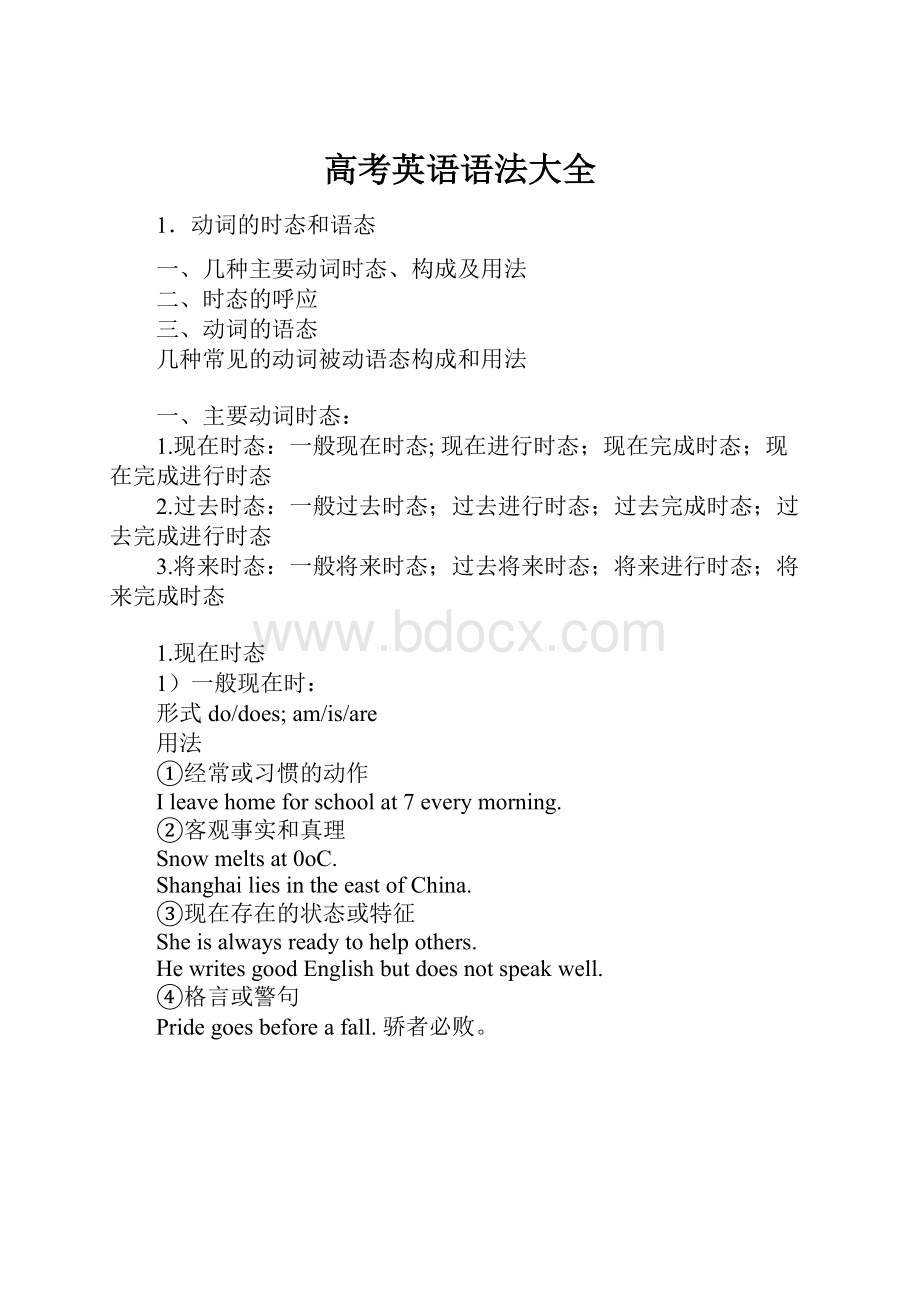高考英语语法大全.docx
《高考英语语法大全.docx》由会员分享,可在线阅读,更多相关《高考英语语法大全.docx(71页珍藏版)》请在冰豆网上搜索。

高考英语语法大全
1.动词的时态和语态
一、几种主要动词时态、构成及用法
二、时态的呼应
三、动词的语态
几种常见的动词被动语态构成和用法
一、主要动词时态:
1.现在时态:
一般现在时态;现在进行时态;现在完成时态;现在完成进行时态
2.过去时态:
一般过去时态;过去进行时态;过去完成时态;过去完成进行时态
3.将来时态:
一般将来时态;过去将来时态;将来进行时态;将来完成时态
1.现在时态
1)一般现在时:
形式do/does;am/is/are
用法
①经常或习惯的动作
Ileavehomeforschoolat7everymorning.
②客观事实和真理
Snowmeltsat0oC.
ShanghailiesintheeastofChina.
③现在存在的状态或特征
Sheisalwaysreadytohelpothers.
HewritesgoodEnglishbutdoesnotspeakwell.
④格言或警句
Pridegoesbeforeafall.骄者必败。
⑤根据规定、日历、时间表预计要发生的动作或事件
ChristmasfallsonaSundaynextyear.
Theplanetakesoffat8a.m.tomorrow.
⑥主将从现。
常见的从属连词:
when,before,after,till,once,if,unless,as/solongas,assoonas,themoment,theminute,thesecond,immediately,theday,theyear等
Ifitrainstomorrow,wewillstayathome.
Whenyoucomenexttime,I’llshowyouaroundourcampus.
HeisgoingtovisithisauntthedayhearrivesinBeijing.
⑦在动词hope,makesure等宾语从句中(表将来)
Ihopethattheyhaveanicetimenextweek.
Makesurethatthewindowsareclosedbeforeyouleavetheroom.
⑧表示“报纸上说”、“书上说”
Thenewspapersaysthatitisgoingtoraintomorrow.
⑨叙述往事,使其生动
Napoleon’sarmynowadvancesandthegreatbattlebegins.
⑩句型:
Herecomes…/Theregoes…
Herecomesthebus.
Theregoesthebell.
2)现在进行时:
形式am/is/are+doing
用法
①说话时正在进行的动作
②目前正在发生的动作,但说话时,动作未必发生
--Whatareyoudoingrecently?
--I’mlearningtodrivethesedays.
③瞬间动词可用现在进行时表示即将发生的动作
go,come,leave,start,arrive,die,give,return,take,get,seeoff,reach等
I’mleavingforShanghaitomorrow.
④描述将来的安排
Theyareopeningthatnewsupermarketnextweek.
⑤表示渐变,常见的动词get,grow,become,turn,begin,go等
Theweatherisgettingwarmerandwarmer.
Theleavesareturningred.
⑥现在进行时与always,constantly,forever,continually连用时,表示说话人的某种感情(赞许,奇怪、厌烦等)
Heisalwaysthinkingofothers.(赞许)
Thecouplesarealwaysquarrellingaboutlittlethings.(不理解,厌烦)
Heisconstantlydisturbingme.(厌烦)
Myparentsarecontinuallycriticizingme.(厌烦)
★不用于进行时态的动词:
表示知道或了解的动词believe,know,doubt,forget,imagine,remember,realize,suppose,understand,…
表示“看起来”、“看上去”的动词appear,seem,resemble,look,…
表示喜爱或不喜爱的动词like,love,prefer,dislike,hate,…
表示构成或来源的动词be,comefrom,contain,include,…
表示拥有、需要、愿望的动词belongto,need,own,possess,want,wish…
3)现在完成时:
形式have/has+done
用法
①过去发生的动作到现在为止已经完成或刚刚完成
Nowwehaveplantedallthetrees.
I’vejustreceivedaletter.
②发生在过去但对现在有影响的动作
I’velostmykeys.(Ican’topenthedoor.)
Maryhas(already)gonetoJapan.
③发生在过去,持续到现在的动作,可能刚刚结束也可能还要继续延续下去。
常与since,for,sofar,until(till,upto)now,uptothepresent,in/duringthepast(last,recent)few(several,two…)months(days…)等时间状语连用。
ShehasbeenheresincelastMonth.
TheyhavelearnedEnglishforaboutsixyears.
Sofarshehaswrittenfivebooks.
Uptonow,Ihavefinishedtwo-thirdsofthework.
④句型It/Thisisthefirst/secondtimethatS.+has/havedone
ThisisthefirsttimethatIhavevisitedChina.
4)现在完成进行时:
形式have/hasbeendoing
用法
①表示一个动作从过去开始,一直延续到现在,强调动作刚停止或仍在继续,可跟allday,allnight,fortwohours,thesefewweeks,sinceearlymorning等时间状语连用。
I’vebeenreadingthisbookfortwohours,butIhaven’tfinishedit.
He’sbeendoinghisscienceprojectallnight.
②表示某个重复动作,一般带有感情色彩。
Shehasalwaysbeenworkinglikethat.
2.过去时态:
1)一般过去时
形式did,was/were
用法
①过去时间内发生的动作或存在的状态
Wehadameetingyesterday.
②过去一段时间内,经常性、习惯性的状态或动作
Whenwewerechildren,wealwayshadalotofquestionstoask.
2)过去进行时
形式was/were+doing
用法:
①过去某一时刻或一段时间内正在进行的动作
IwaswatchingaTVplayat8p.m.yesterdayevening.
Atthattimehewasservinginthearmy.
②某些瞬间动词的过去进行时表示过去即将发生的动作。
如:
go,come,leave,arrive,start,die等
Theytoldmethattheywerearrivingatseventhenextmorning.
③描述故事发生的背景或状态
Hewassleepingunderatreewhenthestormbegan.
④有礼貌的请求
Iwaswonderingifyoucouldrecommendagoodrestaurant.
Iwashopingyoumighthelpmewiththisapplicationform.
3)过去完成时
形式had+done
用法
①表示在过去某一时间或动作前已发生或完成的动作,即“过去的过去”,常与by,before等过去时间状语连用。
Ihadfinishedthenovelbynineo’clock.
WehadlearnedovertwothousandEnglishwordsbytheendoflastterm.
TheyhadplantedsixhundredtreesbeforelastSunday.
②用于said,told,knew,heard,thought等动词后的宾语从句中,常与for或since时间状语连用。
Shesaidshehadnotheardfromhimsincelastyear.
HetoldmethathehadneverbeentoParis.
③动作前后关系:
动作在前的用过去完成时,在后的用一般过去时
WhenIgottothestation,thetrainhadalreadyleft.
Theyounggirlsittingnexttomeontheplanewasverynervous.Shehadneverflownbefore.
④在包含由after,before,assoonas等连词的复合句中,如果两个动作紧接着发生,可不用过去完成时。
Afterwe(had)saidgood-byetothestudents,welefttheschool.
Assoonashe(had)arrived,hegaveusaphonecall.
⑤hope,expect,intend,mean,want,suppose,think等动词的过去完成时表示过去未曾实现的愿望或意图
IhadhopedtoseemoreofShanghai.
Ihadthoughtyouwouldcome,butyoudidn’t.
⑥固定句式
ItwasthethirdtimethatS.+haddone;
Itwas+一段时间+…since…haddone…;
Hardlyhad…donewhen…did…
Nosoonerhad…donethan…did…
Itwasthethirdtimethathehadmadethesamemistake.
Itwastenyearssincewehadenjoyedourselves.
HardlyhadIgothomewhentherainpoureddown.
4)过去完成进行时
形式hadbeen+doing
用法
①表示在过去某一时刻以前开始,一直延续到这一过去时刻,并仍可能继续进行的动作,常与allthetime,allday,for,since,by等时间状语连用。
Itwassixandhewastiredbecausehehadbeenworkingsincedawn.
TheyhadbeenworkingontheprogramforalmostoneweekbeforeIjoinedthem.
②表示过去反复的动作。
Hehadbeentryingtogetheronthephone.
3.将来时态
1)一般将来时
形式shall/will+do;
am/is/aregoingto+do;
am/is/are(about)to+do
am/is/arecoming(leaving,taking,dying…)
用法
shall/will+do
①表示将要发生的动作或状况
Weshall/willhaveaparentmeetingnextweek.
②表示一种倾向或习惯性动作
Cropswilldiewithoutwater.(倾向)
Oilwillfloatonwater.(习惯性动作)
③依据观点或信念揣测未来
He’llmakeagooddoctor.
④表示预见、意图
Ihopethathewillbeabletogototheparty.
⑤说话瞬间做出突然决定
IthinkI’llgoforawalk--I’veaslightheadache.
⑥主将从现
Ifitrainstomorrow,wewillstayathome.
Whenyoucomenexttime,I’llshowyouaroundourcampus.
am/is/aregoingto+do
①打算、准备要做的事
I’mgoingtostudymedicine.
②根据观察到的迹象、证据做出推测
Lookattheseclouds.It’sgoingtorain.
He’sgoingtofailthetest.
am/is/are(about)to+do表示即将进行的动作,不与时间状语连用
We’reabouttoleave.
am/is/areto+do表示预定、义务、命令或吩咐等
HeistoreturnfromGermanytomorrow.(预定)
Nooneistoleavetheroomwithoutpermission.(命令)
2)过去将来时
形式would/should+do;
was/weregoingtodo;
was/wereaboutto+do;
was/wereto+do
用法
①表示从过去某时看将要发生的动作,常用于宾语从句,主句的谓语动词用过去时
Hesaidthathewouldspeakatthemeeting.
Hewassixty-eight.Intwoyearshewouldbeseventy.
②表示过去的愿望或倾向,常用于否定句,意思是“不会、不肯”
Iknewhewouldneverpermitsuchathing.
③was/wereaboutto+do表示过去正要进行的动作
Iwasabouttoleavewhenthetelephonerang.
④was/weregoingtodo和was/wereto+do表过去按计划、安排要发生的事
Iwastoldthatthepressconferencewasgoingtobeheld/wastobeheldthenextday.
3)将来进行时
形式will/shallbe+doing
用法
①表示将来某时刻或某段时间正在进行的动作,常与下列时间状语连用:
thistime+tomorrow/nextweek…,at…/from…to…/between…and…/+将来时间
Wewillbeseeingafilmthistimetomorrowafternoon.
IwillbehavinganEnglishclassat8tomorrow.
Shewillbetypinganarticlefrom2:
00to4:
00thisafternoon.
②表示按计划或安排将要发生的动作
TomwillbemeetingMr.Blackattheairport.
4)将来完成时
形式will/shall+havedone
用法
表示到将来某一时间之前已经完成的动作或状态,常跟下列时间状语连用:
by+将来时间,bytheendof+将来时间,bythetime+从句
Bytomorrowmorning,theweatherwillhaveclearedup.
Bytheendofthismonth,wesurelywillhavefoundasatisfyingsolutiontotheproblem.
Theconferencewillhavelastedafullweekbythetimeitends.
二、时态的呼应
1.定义:
2.时态呼应的情况:
1)主句的谓语动词为现在时态,从句中的谓语动词依需要而定(该用什么时态就用什么时态)
SheknowsyouhavebeeninBeijingforfiveyears.
2)主句中的谓语动词为过去时态,从句谓语动词根据表示的时间而定
①如从句谓语动词所表示的动作与主句谓语动词表示的动作同时发生,从句中用一般过去时或过去进行时
Shesaidshewasbusythen.
②如从句谓语动词表示的动作发生在主句谓语动词表示的动作之前,从句中须用过去完成时
Ididn'tknowthatshehadbeentoLondontwice.
③从句谓语动词表示的动作发生在主句谓语动词所表示的动作之后,从句用过去将来时
Theydidn'tknowwhentheywouldhavearest.
④从句中的情态动词must,should/oughtto,need,dared无时态变化
HethoughtthatIneednottellyouthetruth.
⑤如从句说明的是一种普遍真理现象,谓语动词仍用一般现在时
WhenIwasalittlechild,myfathertoldmethattheearthisround.
⑥从句中有表示具体过去时间的状语,虽然其谓语动词表示的动作发生在主句谓语动词表示的动作之前,从句仍用一般过去时;但如果该状语表示的时间不具体,则从句要用过去完成时
Tomsaidhewasbornin1975.
Tomsaidhehadseenthefilm.
三、动词的语态
主动语态:
主语是动作的执行者
被动语态:
主语是动作的承受者
形式am/is/are+done
常用的几种被动语态
被动
一般现在时
am/is/are+done
现在进行时
am/is/are+beingdone
现在完成时
have/has+beendone
一般过去时
was/were+done
过去进行时
was/were+beingdone
过去完成时
hadbeen+done
一般将来时
willbe+done
is/aregoingtobedone
过去将来时
wouldbe+done
was/weregoingtobedone
将来完成时
willhavebeen+done
情态动词
情态动词+be+done
1.几种需要使用被动语态的情况
1)不知道动作的执行者或不必说出动作的执行者(可省by短语)
Theclassroomiscleanedeveryday.
Mybikewasstolenlastnight.
2)强调或侧重动作的承受者
Smokersarepersuadedtogiveupsmokingbydoctors.
TheprojectisgoingtobesponsoredbyUNESCO.
Thehousehasbeenwashedawaybytheflood.
3)出于委婉、礼貌而避免说出动作执行者
Youarewishedtodoitmorecarefully.
4)Itissaid(believed,considered,expected,reported,supposed,thought…)that+从句
Itissaidthattheboyhaspassedthecollegeentranceexamination.=Theboyis